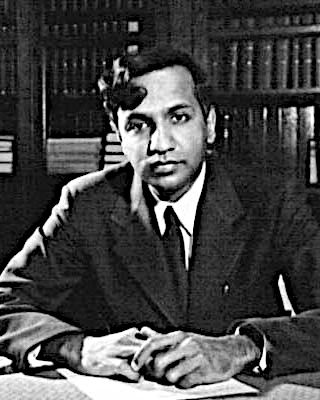
Subrahmanyan Chandrasekhar (1910 – 1995) was an Indo-American astrophysicist whose work revolutionized our understanding of stellar evolution. Born on October 19, 1910, in Lahore (then in British India, now in Pakistan) into a Tamil Brahmin family, he was the nephew of physicist Chandrasekhara Venkata Raman (1888-1970), winner of the Nobel Prize in Physics in 1930.
After brilliant studies at Presidency College in Madras, he received a scholarship to continue his research at the University of Cambridge in 1930. It was during his boat journey to England, at just 19 years old, that he developed his theory on the Chandrasekhar limit, a fundamental concept in astrophysics.
In 1930, Chandrasekhar calculated that a white dwarf cannot have a mass greater than 1.4 times the mass of the Sun (precise value: \(1.44 M_{\odot}\)). Beyond this limit, the star collapses under its own gravity to become either a neutron star or a black hole.
This theory, presented at a conference at the Royal Astronomical Society in 1935, was strongly criticized by Arthur Eddington (1882-1944), one of the leading figures in astrophysics at the time. Eddington called this idea "absurd," declaring that "there must be a law of nature to prevent a star from behaving in such an absurd way." This initial rejection deeply marked Chandrasekhar but did not prevent him from continuing his research.
Throughout his career, Chandrasekhar made fundamental contributions to several fields:
| Field | Contribution | Impact | Year |
|---|---|---|---|
| Stellar structure | Theory of white dwarfs and critical mass limit | Foundation for the study of compact objects | 1930-1935 |
| Stellar dynamics | Studies on mass transfer in binary systems | Understanding of novae and supernovae | 1940s |
| General relativity | Precise calculations of geodesics in Kerr spacetime | Application to rotating black holes | 1960s |
| Hydrodynamics | Theory of magnetohydrodynamic waves | Applications in solar physics | 1950s |
After earning his PhD from Cambridge (1933), Chandrasekhar joined the University of Chicago in 1937, where he spent his entire career. He founded the famous Astrophysical Journal and trained several generations of astrophysicists. Among his most famous students were Eugene Parker (1927-2022), discoverer of the solar wind, and John N. Bahcall (1934-2005), pioneer in neutrino astronomy.
His contributions were eventually recognized through:
Chandrasekhar's work profoundly marked modern astrophysics:
As Stephen Hawking (1942-2018) noted: "Chandrasekhar's work on the white dwarf limit was one of the first indications that general relativity could have dramatic physical consequences for astrophysical objects."
| Work | Field | Year | Significance |
|---|---|---|---|
| An Introduction to the Study of Stellar Structure | Stellar structure | 1939 | Foundational work in theoretical astrophysics |
| Principles of Stellar Dynamics | Stellar dynamics | 1942 | Reference treatise on stellar systems |
| Radiative Transfer | Radiative transfer | 1950 | Fundamental study of stellar atmospheres |
| Hydrodynamic and Hydromagnetic Stability | Fluid stability | 1961 | Applications in astrophysics and geophysics |
| The Mathematical Theory of Black Holes | General relativity | 1983 | Synthesis of work on black holes |
| Year | Event | Context |
|---|---|---|
| 1910 | Born in Lahore (British India) | In a family of scientists (nephew of C.V. Raman) |
| 1930 | Discovery of the Chandrasekhar limit during his voyage to England | Aboard the ship SS Strathnaver |
| 1933 | PhD from the University of Cambridge | Under the supervision of Ralph Fowler |
| 1937 | Joined the University of Chicago | Beginning of a 60-year career |
| 1983 | Nobel Prize in Physics | Shared with William A. Fowler |
| 1995 | Death in Chicago | From heart complications |
| 1999 | Launch of the Chandra X-ray Observatory | Space observatory named in his honor |